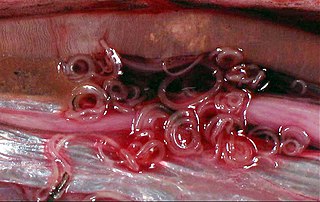Leptosomatidae is a family of benthic marine nematode worms.

Enoplea (enopleans) is a class, which with the classes Secernentea and Chromadorea make up the phylum Nematoda in current taxonomy. The Enoplea are considered to be a more ancestral group than the Chromadorea, and researchers have referred to its members as the "ancestrally diverged nematodes", compared to the "more recently diverged nematodes" of Chromadorea.

Secernentea was a class of nematodes in the Classical Phylogeny System and is no longer in use. This morphological-based classification system has been replaced by the Modern Phylogeny system, where taxonomy assignment is based on small subunit ribosomal DNA.

The Chromadorea are a class of the roundworm phylum, Nematoda. They contain a single subclass (Chromadoria) and several orders. With such a redundant arrangement, the Chromadoria are liable to be divided if the orders are found to form several clades, or abandoned if they are found to constitute a single radiation.
Pratylenchus brachyurus is a plant parasitic nematode.

Anguina is a genus of plant pathogenic nematodes.

Diplogasterida was an order of nematodes. It was sometimes placed in a monotypic subclass Diplogasteria, but molecular phylogenetic evidence has shown it to be embedded in the family Rhabditidae. The confusion of having a hierarchical nesting of groups that were formerly mutually exclusive has led to a profusion of names. Although completely revised taxonomy of nematodes that builds on recent classification systems as well as recent phylogenetic evidence is still necessary, most contemporary taxonomic studies now treat all groups listed under "Diplogasterina" below as a single family, Diplogastridae.

The nematodes, roundworms or eelworms constitute the phylum Nematoda. They are a diverse animal phylum inhabiting a broad range of environments. Most species are free-living, feeding on microorganisms, but there are many that are parasitic. The parasitic worms (helminths) are the cause of soil-transmitted helminthiases.
Enoplida is an order of nematodes. It is one of two orders in Enoplia, which is one of two subclasses in Class Enoplea.
Dorylaimia is a subclass of nematodes.
Hoplolaimus galeatus is a plant pathogenic nematode.
The Enoplia are a subclass of nematodes in the class Enoplea.
Ingenia is a genus of marine nematode worms native to Brazil, with a single known species, I. mirabilis. It belongs to the Tripyloididae, which is a group that are mostly free-living and which feed on diatoms and other algaes.
Paratrichodorus is a genus of terrestrial root feeding (stubby-root) nematodes in the Trichodoridae family (trichorids), being one of five genera. They are economically important plant parasites and virus vectors. The females are didelphic, and are distributed worldwide.
Triplonchida is an order of terrestrial nematodes, and is one of two orders making up the subclass Enoplia.
Trichodoridae is a family of terrestrial root feeding nematodes, being one of two that constitute suborder Triplonchida. They are economically important plant parasites and virus vectors.

Trichodorus is a genus of terrestrial root feeding (stubby-root) nematodes in the Trichodoridae family (trichorids), being one of five genera. They are economically important plant parasites and virus vectors.

Nacobbus is a genus of plant-parasitic nematodes. Prevalent in North and South America, the genus Nacobbus threatens crops such as tomato, potato, quinoa and sugarbeet. They can cause so much damage that they are considered to be of quarantine importance. The morphology and biology of Nacobbus is not all that well known, although it is possible that the host—in this case, a specific crop—influences how the morphological characteristics of these nematodes are expressed.
Bunonematidae is a family of nematodes in the order Rhabditida.
Phasmarhabditis (Greek: Phasma = (φάσμα ; rhabditis = is a genus of bacterial-feeding nematodes which are facultative parasites whose primary hosts are terrestrial gastropods. The name comes from Greek: Phasma- (φάσμα ; rhabditis = rod-like (ῥάβδος. The genus is made up of 18 species including P. hermaphrodita, P. californica, P. neopapillosa, P. papillosa, P. apuliae, P. bohemica, P. bonaquaense, P. huizhouensis, P. nidrosiensis, P. valida and P. tawfiki.







